Eric C. Sheninger's Blog, page 53
May 24, 2015
Leaders Don't Boss
"Leaders care about why things get done. Bosses just want things to get done. Bosses maintain order for the sake of order. Leaders introduce order for the sake of progress." - Akshay Kapur
Do you work for a boss or with a leader? Are you a boss or a leader? This is an extremely important question where the answer is probably indicative of the climate in which you work and the success (or lack thereof) of change initiatives. The fact of the matter is people choose to be either a boss or a leader. This choice can have a monumental impact on any organization. The image below really got me thinking about leaders vs. bosses:
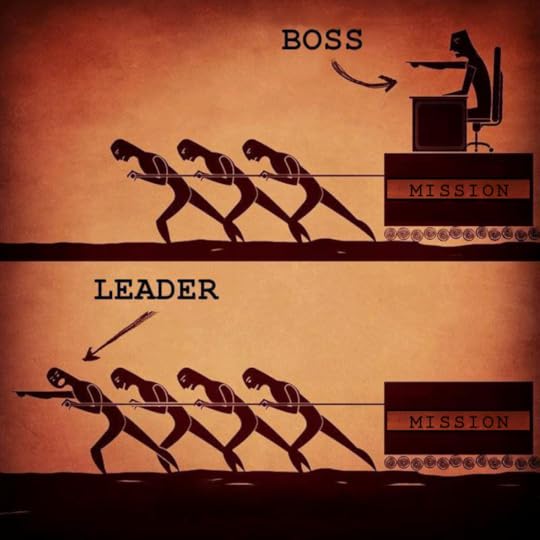 Image credit: http://msl-cdn.radiantforestllc.netdn...
Image credit: http://msl-cdn.radiantforestllc.netdn...
The image can be interpreted in many ways while helping to bring some clarity on how we can all improve. Leadership is a choice that evolves over time through one’s actions. Leaders look to constantly improve and help others to do the same. Bosses care very little about self-improvement and are more focused on extrinsic motivational factors.
More than one individual
Change does not come from one person. Leaders believe in servitude while embracing the collective strengths and abilities of all people in an organization. They work hard to build a team and use the hiring process to surround themselves with smart people. Great leaders do not shy away from hiring people that are smarter than them and are not afraid to admit it. Consensus and shared decision-making are strategies commonly used to foster embracement for change, which ultimately leads to success. Leaders work tirelessly to build relationships with everyone through collaboration, trust, and respect. The power of many always trumps that of one. Bosses on the other hand expect everyone to serve them. Their specific title and self-perceived power that comes with it leads to a sense of entitlement.
Example moves the masses
Leaders never ask others to do what they are not willing to do themselves. They model the way and use their example as a means to move a change initiative forward. Leaders understand that talk is cheap and opinions do absolutely nothing in the long run to successfully implement change. Their actions speak for themselves and are used as catalysts to inspire others to join in. Bosses command and direct others to do what they are not willing to do themselves. They use talk and rhetoric as the main drivers to force an agenda forward or have others do their bidding. Bosses do not see the inherent value in spending the time and effort to participate in actively building a better culture leading to improvement.
Implement vision into action
Leaders work with others to develop a vision to help move a mission forward. In the case of schools, these people ensure measures of action result in the vision becoming a reality so that all students learn and overall achievement increases. Great leaders focus on the vision for the mission’s sake. Bosses set the vision themselves, usually in the form of a mission statement. They then sit on top of this mission statement and use it to promote themselves when others succeed.
Expect more and work harder
True leaders set high expectations of themselves. They understand by doing so the workload increases as progress is made. Leaders that have raised the bar and let their work be the example motivate and inspire others to do the same. They focus on solutions instead of excuses. Bosses on the other hand expect to reap rewards and benefit from the hard work of others.
Bosses come in many forms, as do leaders. They are not just with people you might work for, but also those in positions of authority. When I look at current education reform efforts across the globe I see endless examples of bosses, but very few leaders. I can also say the same about the social media space. There needs to be less telling educators what to do and more showing them how to do it. If not, then those individuals are no better than many of the bosses that they complain about.
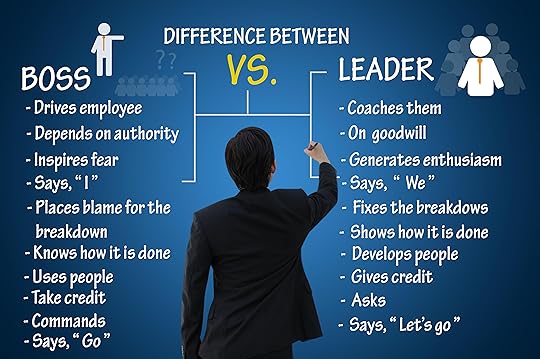 Image credit: http://sinsip.com/st.jpg
Image credit: http://sinsip.com/st.jpg
Bosses tell others what to do. Leaders on the other hand take them where they need to be.
Do you work for a boss or with a leader? Are you a boss or a leader? This is an extremely important question where the answer is probably indicative of the climate in which you work and the success (or lack thereof) of change initiatives. The fact of the matter is people choose to be either a boss or a leader. This choice can have a monumental impact on any organization. The image below really got me thinking about leaders vs. bosses:
 Image credit: http://msl-cdn.radiantforestllc.netdn...
Image credit: http://msl-cdn.radiantforestllc.netdn...The image can be interpreted in many ways while helping to bring some clarity on how we can all improve. Leadership is a choice that evolves over time through one’s actions. Leaders look to constantly improve and help others to do the same. Bosses care very little about self-improvement and are more focused on extrinsic motivational factors.
More than one individual
Change does not come from one person. Leaders believe in servitude while embracing the collective strengths and abilities of all people in an organization. They work hard to build a team and use the hiring process to surround themselves with smart people. Great leaders do not shy away from hiring people that are smarter than them and are not afraid to admit it. Consensus and shared decision-making are strategies commonly used to foster embracement for change, which ultimately leads to success. Leaders work tirelessly to build relationships with everyone through collaboration, trust, and respect. The power of many always trumps that of one. Bosses on the other hand expect everyone to serve them. Their specific title and self-perceived power that comes with it leads to a sense of entitlement.
Example moves the masses
Leaders never ask others to do what they are not willing to do themselves. They model the way and use their example as a means to move a change initiative forward. Leaders understand that talk is cheap and opinions do absolutely nothing in the long run to successfully implement change. Their actions speak for themselves and are used as catalysts to inspire others to join in. Bosses command and direct others to do what they are not willing to do themselves. They use talk and rhetoric as the main drivers to force an agenda forward or have others do their bidding. Bosses do not see the inherent value in spending the time and effort to participate in actively building a better culture leading to improvement.
Implement vision into action
Leaders work with others to develop a vision to help move a mission forward. In the case of schools, these people ensure measures of action result in the vision becoming a reality so that all students learn and overall achievement increases. Great leaders focus on the vision for the mission’s sake. Bosses set the vision themselves, usually in the form of a mission statement. They then sit on top of this mission statement and use it to promote themselves when others succeed.
Expect more and work harder
True leaders set high expectations of themselves. They understand by doing so the workload increases as progress is made. Leaders that have raised the bar and let their work be the example motivate and inspire others to do the same. They focus on solutions instead of excuses. Bosses on the other hand expect to reap rewards and benefit from the hard work of others.
Bosses come in many forms, as do leaders. They are not just with people you might work for, but also those in positions of authority. When I look at current education reform efforts across the globe I see endless examples of bosses, but very few leaders. I can also say the same about the social media space. There needs to be less telling educators what to do and more showing them how to do it. If not, then those individuals are no better than many of the bosses that they complain about.
 Image credit: http://sinsip.com/st.jpg
Image credit: http://sinsip.com/st.jpg Bosses tell others what to do. Leaders on the other hand take them where they need to be.
Published on May 24, 2015 08:03
May 17, 2015
A Time and Place For Buy-In
Maybe it’s just me, but I can’t stand the term “buy-in” when it comes to change. It is one of these phrases that has outlived its usefulness, if in fact sustainable change leading to transformation is the ultimate goal. More often than not, this leadership tactic is put into play to get educators on board with specific mandates and directives that have been pushed down from either the state government or central office. In my opinion, this is the only time when looking for buy-in is appropriate because you really don’t have much of a choice in the matter. It is in these situations that leaders have to “sell” others on the importance of change whether or not they actually find value in it themselves. We have to do so by developing a concrete strategy comprised of compelling reasons to get staff on board with these changes even though we ourselves never actually bought in.
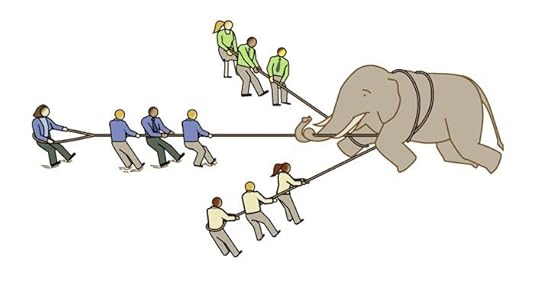 Image credit: http://www.bizmanualz.com/wpblog/wp-c...
Image credit: http://www.bizmanualz.com/wpblog/wp-c...
As a principal this was always a tough pill for me to swallow. I often felt guilty as I addressed my staff with an elevator pitch loaded with reasons as to why these changes were needed. In these situations my role became more about selling change. Thus educational leadership in many regards has morphed leaders into sales reps who have to move an agenda forward even if the outcome will not help to positively transform school culture. It comes as no surprise that initiatives implemented through a buy-in approach rarely are sustained to a point where there is a noticeable lasting impact on culture.
Real change that is sustained does not come from buy-in. If you have to sell people on change then you will always have to spend precious time keeping people bought-in. With buy-in the leader becomes, and remains, the focus of the change initiative. If there is one thing I learned during my time as a school leader, where many successful changes were successfully implemented over a short period of time, it was that change has to be embraced by all stakeholders. When educators have to be coerced through a buy-in approach animosity and resentment often follow.
Our approach focused on putting our stakeholders in a position to experience the value of change firsthand. Instead of a one-size-fits-all methodology to moving the masses to where we wanted them to be, we instead identified those among the staff who exhibited powerful leadership attributes and empowered them to be agents of change. I still provided an overall explanation to my entire staff as to why we needed to change certain things and how we could go about it, but allowed everyone to go at their own pace initially. This allowed me to focus time, energy, and resource on a smaller group of go-getters who I had hoped would be the key. The calculated gamble paid off. This team of teacher and student leaders was put in a position to experience the value of changes we supported as administrators, but they championed through their successes. They owned the process and I shared their successes far and wide.
I might have played my part by bragging about the successes this group experienced early on, but it was their actions that compelled their colleagues to move in a different direction and embrace change. There is nothing more powerful than the act of modeling when it comes to initiating and sustaining change. It is at this point that stakeholders embrace new and different ways of doing work because they want to, not because they have to. The true leaders of change are our teachers and students. Great leaders, in my opinion, remove all excuses by providing the necessary support. Place people in a position to experience firsthand the benefits of the change and they will do the hard work of moving the masses.
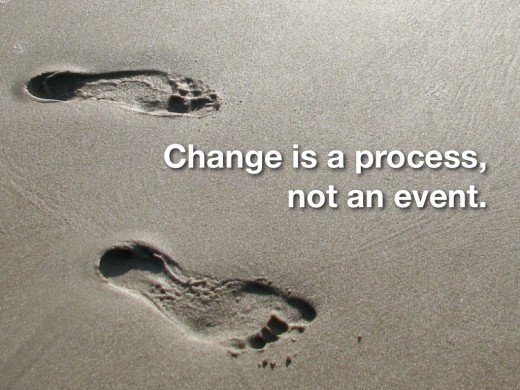 Image credit: http://usercontent2.hubimg.com/818724...
Image credit: http://usercontent2.hubimg.com/818724...
Think about changes that you have made on a professional level. Did you have to “buy-in” in order to make those changes or did you embrace them once you experienced the inherent value for yourself? I would guess the latter and that is why the change took hold resulting in an improvement of professional practice. For change to be successful and last the test of time it has to be embraced. The next time you are in a position to implement needed change think about how you will approach it in a way that focuses on embracement as opposed to buy-in.
 Image credit: http://www.bizmanualz.com/wpblog/wp-c...
Image credit: http://www.bizmanualz.com/wpblog/wp-c...As a principal this was always a tough pill for me to swallow. I often felt guilty as I addressed my staff with an elevator pitch loaded with reasons as to why these changes were needed. In these situations my role became more about selling change. Thus educational leadership in many regards has morphed leaders into sales reps who have to move an agenda forward even if the outcome will not help to positively transform school culture. It comes as no surprise that initiatives implemented through a buy-in approach rarely are sustained to a point where there is a noticeable lasting impact on culture.
Real change that is sustained does not come from buy-in. If you have to sell people on change then you will always have to spend precious time keeping people bought-in. With buy-in the leader becomes, and remains, the focus of the change initiative. If there is one thing I learned during my time as a school leader, where many successful changes were successfully implemented over a short period of time, it was that change has to be embraced by all stakeholders. When educators have to be coerced through a buy-in approach animosity and resentment often follow.
Our approach focused on putting our stakeholders in a position to experience the value of change firsthand. Instead of a one-size-fits-all methodology to moving the masses to where we wanted them to be, we instead identified those among the staff who exhibited powerful leadership attributes and empowered them to be agents of change. I still provided an overall explanation to my entire staff as to why we needed to change certain things and how we could go about it, but allowed everyone to go at their own pace initially. This allowed me to focus time, energy, and resource on a smaller group of go-getters who I had hoped would be the key. The calculated gamble paid off. This team of teacher and student leaders was put in a position to experience the value of changes we supported as administrators, but they championed through their successes. They owned the process and I shared their successes far and wide.
I might have played my part by bragging about the successes this group experienced early on, but it was their actions that compelled their colleagues to move in a different direction and embrace change. There is nothing more powerful than the act of modeling when it comes to initiating and sustaining change. It is at this point that stakeholders embrace new and different ways of doing work because they want to, not because they have to. The true leaders of change are our teachers and students. Great leaders, in my opinion, remove all excuses by providing the necessary support. Place people in a position to experience firsthand the benefits of the change and they will do the hard work of moving the masses.
 Image credit: http://usercontent2.hubimg.com/818724...
Image credit: http://usercontent2.hubimg.com/818724...Think about changes that you have made on a professional level. Did you have to “buy-in” in order to make those changes or did you embrace them once you experienced the inherent value for yourself? I would guess the latter and that is why the change took hold resulting in an improvement of professional practice. For change to be successful and last the test of time it has to be embraced. The next time you are in a position to implement needed change think about how you will approach it in a way that focuses on embracement as opposed to buy-in.
Published on May 17, 2015 17:01
May 11, 2015
Turn Students from Passive Listeners into Engaged Learners with imakiku
The following is a sponsored blog post by imakiku.
Student engagement that leads to actual learning is the goal of any pedagogically sound lesson. With that in mind have you ever pondered the following questions?
What do the students think while in class?What are students interested in now?How do I know if they are actually learning?
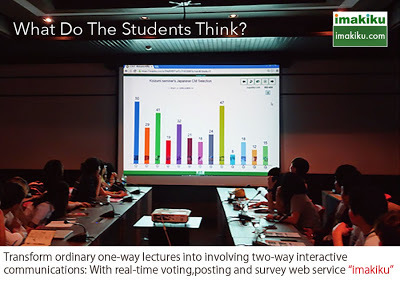
These questions are a major concern for many teachers, as they want to know what the students think while in class. Advances in web-based technologies now offer teachers the ability to answer these questions in a more holistic manner. Today I introduce a new web browser based tool called imakiku, which is sure to enhance formative assessment in your classroom.
Imakiku enables real-time voting, posting, and survey capabilities through the use of smartphones, tablets, or laptops. It is specifically optimized for these mobile devices. Simple, intuitive interfaces make everything easy for both teachers and students alike - from creating and asking questions, making comments, designing and completing surveys. You do not need extra devices. There is no software to download and registration is not necessary. Your students simply log in using the participation code that is provided.
The teacher goes to imakiku.com and prepares the questions.
Students go to sugukiku.com; login and participate.
It’s that simple!
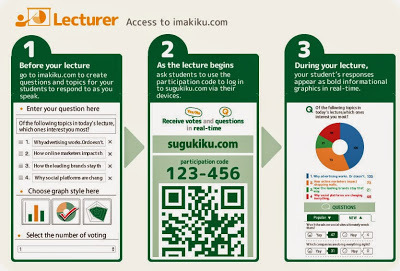 For Teacher: imakiku.com
For Teacher: imakiku.com
Here are some more detailed instructions for the teacher:
Before the class go to imakiku.com to create questions and topics for the students to respond to during the lesson.As the class begins, ask the students to use the participation code to log in to sugukiku.com via their devices.During the class the student responses will appear as bold informational graphics in real-time.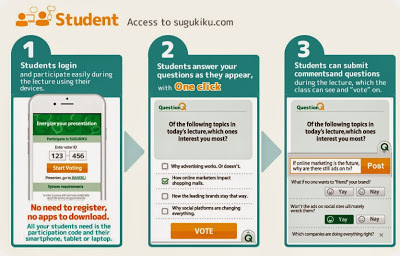 For Students : sugukiku.com
For Students : sugukiku.com
Instructions for the students are as follows:
As the class begins students login and participate during the class using their devices. During the class students answer the questions with “one click”. They can also submit comments and questions during the class, which the class can see and “vote” on.You can access a free trial until 12/31/2015 for general use. For readers of A Principal's Reflections the trial is free until 3/31/2016 by using a special code. Visit imakiku, click on the orange sign up button, copy and paste this code in the promotion box: 20150505_ZVMQODFJSA
After you give imakiku a try, please send your comments/feedback to contact@tenmondo.com. They will then better develop imakiku to reflect your feedback.
Once you grasp what your students think in real time, you can begin to develop even better lessons and learning activities based on their feedback. Students will feel more respected when afforded the opportunity to demonstrate their learning in real-time, thus increasing their active engagement. It will enable your class to keep concentration and motivation high. Above all, your students are more likely to enjoy taking your class.
Give imakiku a try and turn your students from passive listeners into engaged learners.
Visit imakiku’s website to learn more!
Student engagement that leads to actual learning is the goal of any pedagogically sound lesson. With that in mind have you ever pondered the following questions?
What do the students think while in class?What are students interested in now?How do I know if they are actually learning?

These questions are a major concern for many teachers, as they want to know what the students think while in class. Advances in web-based technologies now offer teachers the ability to answer these questions in a more holistic manner. Today I introduce a new web browser based tool called imakiku, which is sure to enhance formative assessment in your classroom.
Imakiku enables real-time voting, posting, and survey capabilities through the use of smartphones, tablets, or laptops. It is specifically optimized for these mobile devices. Simple, intuitive interfaces make everything easy for both teachers and students alike - from creating and asking questions, making comments, designing and completing surveys. You do not need extra devices. There is no software to download and registration is not necessary. Your students simply log in using the participation code that is provided.
The teacher goes to imakiku.com and prepares the questions.
Students go to sugukiku.com; login and participate.
It’s that simple!
 For Teacher: imakiku.com
For Teacher: imakiku.comHere are some more detailed instructions for the teacher:
Before the class go to imakiku.com to create questions and topics for the students to respond to during the lesson.As the class begins, ask the students to use the participation code to log in to sugukiku.com via their devices.During the class the student responses will appear as bold informational graphics in real-time.
 For Students : sugukiku.com
For Students : sugukiku.comInstructions for the students are as follows:
As the class begins students login and participate during the class using their devices. During the class students answer the questions with “one click”. They can also submit comments and questions during the class, which the class can see and “vote” on.You can access a free trial until 12/31/2015 for general use. For readers of A Principal's Reflections the trial is free until 3/31/2016 by using a special code. Visit imakiku, click on the orange sign up button, copy and paste this code in the promotion box: 20150505_ZVMQODFJSA
After you give imakiku a try, please send your comments/feedback to contact@tenmondo.com. They will then better develop imakiku to reflect your feedback.
Once you grasp what your students think in real time, you can begin to develop even better lessons and learning activities based on their feedback. Students will feel more respected when afforded the opportunity to demonstrate their learning in real-time, thus increasing their active engagement. It will enable your class to keep concentration and motivation high. Above all, your students are more likely to enjoy taking your class.
Give imakiku a try and turn your students from passive listeners into engaged learners.
Visit imakiku’s website to learn more!
Published on May 11, 2015 03:16
May 10, 2015
Meet Your Stakeholders Where They Are
Earlier this year I was fortunate enough to have an article published in the digital version of ASCD's Educational Leadership. The title of the article was Transforming Your School with Digital Communication. As technology continues to evolve it will continue to become an even more embedded component of society. With that being said it is important for school leaders to meet their stakeholders where they are at and engage them in two-way communications. Digital leadership calls for a multifaceted approach using both traditional and new age strategies to ensure that the right message is reaching stakeholders in a timely fashion. We can't assume nor rely on communication staples such as snail mail (i.e. paper mailings), newsletters, or websites are the most effective and only ways to get information out.
 Image credit: http://cw.iabc.com/wp-content/uploads...
Image credit: http://cw.iabc.com/wp-content/uploads...
In the article I highlight four reasons why all leaders should embrace a digital communications strategy:
Transparency - Leaders can tackle the constant perception battle by providing more frequent and accurate updates about the daily work occurring in schools. This requires sharing challenges as well as successes and opening yourself to feedback from anyone. In the end transparency through digital communications helps to build positive relationships with key stakeholders.Flexibility - A multifaceted digital communications strategy allows all stakeholders a choice as to how they want to consume information and interact with the school. An added bonus is that there are so many free tools such as Twitter, Google+, blogs, Facebook, and Remind that are free for all to use.Expanded access to learning - In my case digital communications opened my eyes to new and more powerful ways to learn. I then began sharing with groups of teachers several ideas, strategies, and tools I'd acquired from my personal learning network (PLN). As our learning culture began to change it was critical that I was able to articulate these changes to my stakeholders.Sharing the good news - Digital communications compliments and/or enhances any public relations plan. In a time when good news about schools is hard to come by in the mainstream media school leaders can now become the storyteller-in-chief. Digital communications act to amplify the successes that are taking place in schools every day. Image credit: http://www.sais.org/resource/resmgr/2...
Image credit: http://www.sais.org/resource/resmgr/2...
To use social media effectively, you need to see yourself as a learner, not just a leader. Making the shift from traditional to digital leadership demands that you question your own assumptions, acknowledge how much you don't know, take risks, and learn from failure. Just as teachers differentiate instruction for a variety of learning styles in the classroom, school leaders should differentiate communication efforts if the goal is true partnerships between home and school. Leaders have the power to shape the culture of schools. Using social media and digital tools as a lever, you can open the door to new ways of learning, thinking, and communicating for all members of your community.
 Image credit: http://cw.iabc.com/wp-content/uploads...
Image credit: http://cw.iabc.com/wp-content/uploads...In the article I highlight four reasons why all leaders should embrace a digital communications strategy:
Transparency - Leaders can tackle the constant perception battle by providing more frequent and accurate updates about the daily work occurring in schools. This requires sharing challenges as well as successes and opening yourself to feedback from anyone. In the end transparency through digital communications helps to build positive relationships with key stakeholders.Flexibility - A multifaceted digital communications strategy allows all stakeholders a choice as to how they want to consume information and interact with the school. An added bonus is that there are so many free tools such as Twitter, Google+, blogs, Facebook, and Remind that are free for all to use.Expanded access to learning - In my case digital communications opened my eyes to new and more powerful ways to learn. I then began sharing with groups of teachers several ideas, strategies, and tools I'd acquired from my personal learning network (PLN). As our learning culture began to change it was critical that I was able to articulate these changes to my stakeholders.Sharing the good news - Digital communications compliments and/or enhances any public relations plan. In a time when good news about schools is hard to come by in the mainstream media school leaders can now become the storyteller-in-chief. Digital communications act to amplify the successes that are taking place in schools every day.
 Image credit: http://www.sais.org/resource/resmgr/2...
Image credit: http://www.sais.org/resource/resmgr/2...To use social media effectively, you need to see yourself as a learner, not just a leader. Making the shift from traditional to digital leadership demands that you question your own assumptions, acknowledge how much you don't know, take risks, and learn from failure. Just as teachers differentiate instruction for a variety of learning styles in the classroom, school leaders should differentiate communication efforts if the goal is true partnerships between home and school. Leaders have the power to shape the culture of schools. Using social media and digital tools as a lever, you can open the door to new ways of learning, thinking, and communicating for all members of your community.
Published on May 10, 2015 07:35
May 3, 2015
A Title Doesn't Make You a Leader
I pondered just sending out the title of this post as a tweet – short, sweet (well not so much), and to the point. Instead of just throwing out a sound bite into the social media abyss a detailed explanation is in order. Now here’s why. As of late I have been working with a greater number of teachers across the country on digital leadership and learning. During the many conversations that ensue over the course of the workshop a common theme has developed and that is real change can only come from the adults that have a specific title such as Board of Education member, superintendent, other central office administrators, principals, supervisors, etc. Immediately upon hearing this I share stories of many “leaders” by title that I have come in contact with over the years, or observed from afar, that did anything but lead. I would also bet that I am not the only one who feels this way either.

Titles are often squandered that result in lost opportunities to transform organizations in positive ways. Leaders by title alone often exhibit many defining characteristics such as egos, power trips, taking credit for the work of others, handing down mandates/directives, invisibility (i.e. never seen or around when needed), and insecurity when their ideas are challenged out in the open. They commonly tell others what to do without having done it themselves or assisting in the process. I could go on and on, but I think you get the point. Changes that are implemented by leaders by title are never sustained. What scares me the most about leaders by title only is that they have the ability and power to inhibit the changes that are desperately needed. The perception of the term leader needs to change and it begins with you.
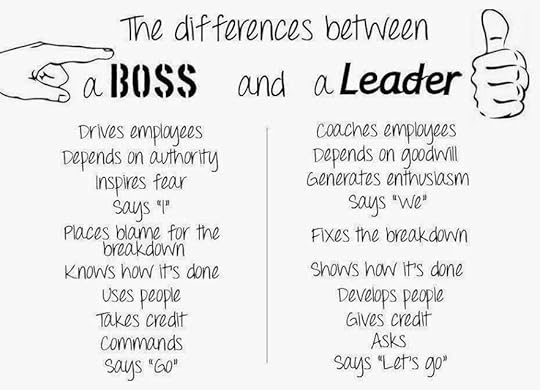 Image credit: https://pbs.twimg.com/media/Bwnk_S4CQ...
Image credit: https://pbs.twimg.com/media/Bwnk_S4CQ...
A title doesn’t automatically anoint one as a leader. Leadership is comprised of a dynamic mix of behaviors, mindset, and skills, which are used to move people where a leader wants them to be for the betterment of the organization. In the case of schools, great leaders help others see the value of change by clearly articulating the why and how to build broad support through consensus. However, a real leader knows when to step in and make the hard decisions that have to be made having calculated the positive outcomes prior. They also stand by these decisions in the face of adversity.
In my opinion all leaders have one thing in common – they do, as opposed to just talk. Leadership is about action, not position. This comes back to the motivation for this post. Some of the best leaders I have seen during my years in education never had a title. What they did have was the tenacity to act on a bold vision for change to improve learning for kids as well as overall school culture. These people are overlooked because they don’t possess the necessary title that is used to describe a leader in a traditional sense.
Make no mistake about the fact that many of you are surrounded by these people each day both physically and virtually. They are teachers, students, parents, and even administrators who have all taken action to initiate meaningful change in their classrooms or schools.These people don’t just talk the talk, but they walk the walk. They lead by example in what might be the most impactful way possible – modeling. These true leaders do not expect others to do what they are not willing to do. The best part is that these unsung heroes do not need a title to make a difference. They also don't need a title to be agents of change.
 Image credit: Tom D'Amico
Image credit: Tom D'Amico
Everyone has the capacity to be a leader through his/her determination to be better for the greater common good. Leaders choose to become so and are ultimately defined by his/her resolve to initiate change in the face of adversity. I believe that leadership is not innate, but rather learned through the actions that we choose to take as well as a critical analysis (both good and bad) of other leaders. So the next time someone with a title is referred to as a leader think about what he or she has really done in his or her respective position to champion real change. Upon pondering that the realization might be that the true leader is actually you even though you don’t have the title.

Titles are often squandered that result in lost opportunities to transform organizations in positive ways. Leaders by title alone often exhibit many defining characteristics such as egos, power trips, taking credit for the work of others, handing down mandates/directives, invisibility (i.e. never seen or around when needed), and insecurity when their ideas are challenged out in the open. They commonly tell others what to do without having done it themselves or assisting in the process. I could go on and on, but I think you get the point. Changes that are implemented by leaders by title are never sustained. What scares me the most about leaders by title only is that they have the ability and power to inhibit the changes that are desperately needed. The perception of the term leader needs to change and it begins with you.
 Image credit: https://pbs.twimg.com/media/Bwnk_S4CQ...
Image credit: https://pbs.twimg.com/media/Bwnk_S4CQ...A title doesn’t automatically anoint one as a leader. Leadership is comprised of a dynamic mix of behaviors, mindset, and skills, which are used to move people where a leader wants them to be for the betterment of the organization. In the case of schools, great leaders help others see the value of change by clearly articulating the why and how to build broad support through consensus. However, a real leader knows when to step in and make the hard decisions that have to be made having calculated the positive outcomes prior. They also stand by these decisions in the face of adversity.
In my opinion all leaders have one thing in common – they do, as opposed to just talk. Leadership is about action, not position. This comes back to the motivation for this post. Some of the best leaders I have seen during my years in education never had a title. What they did have was the tenacity to act on a bold vision for change to improve learning for kids as well as overall school culture. These people are overlooked because they don’t possess the necessary title that is used to describe a leader in a traditional sense.
Make no mistake about the fact that many of you are surrounded by these people each day both physically and virtually. They are teachers, students, parents, and even administrators who have all taken action to initiate meaningful change in their classrooms or schools.These people don’t just talk the talk, but they walk the walk. They lead by example in what might be the most impactful way possible – modeling. These true leaders do not expect others to do what they are not willing to do. The best part is that these unsung heroes do not need a title to make a difference. They also don't need a title to be agents of change.
 Image credit: Tom D'Amico
Image credit: Tom D'AmicoEveryone has the capacity to be a leader through his/her determination to be better for the greater common good. Leaders choose to become so and are ultimately defined by his/her resolve to initiate change in the face of adversity. I believe that leadership is not innate, but rather learned through the actions that we choose to take as well as a critical analysis (both good and bad) of other leaders. So the next time someone with a title is referred to as a leader think about what he or she has really done in his or her respective position to champion real change. Upon pondering that the realization might be that the true leader is actually you even though you don’t have the title.
Published on May 03, 2015 06:16
April 28, 2015
Let Your Work Do The Talking
Let me start off by saying that this post has been brewing for a while based on what I have observed with nothing being directed at me personally. Maybe it is just the way I feel, but I am thinking that this is not the case.
It seems like adults at times are the worse examples for our youth. Take sports for example. I was raised to enjoy many sports for the love of the game, teamwork, and competing amongst friends. Things sure have changed. It is now quite common to observe trash talk among youth and sport athletes. This was rarely the case back in my day. There is a lesson here to teach kids about the inappropriateness of this, but it becomes even tougher when adults constantly model inappropriate behavior. At what point did sportsmanship, manners, etiquette and modeling appropriate behavior not become important?
This type of behavior is also found in the online world. I entered the online world in 2009 and can honestly say a great deal has changed. It sort of parallels the example above in the youth athletics arena. From my point of view (and only mine), it was a much more welcoming space where mutual respect was earned through constructive discourse, dialogue, and collaboration. In many cases it now seems to be dominated by competition, cliques, and people trying to one up each other all the time. I have seen the conversational tone lessen and more attacks, jabs, and isolation of certain groups evolve over time. Belittlement has become the flavor of the month for one too many.
I still believe in the power of the space and constantly find inspiration in the work of others. Yes, the pettiness of some has driven me to write this post, but I do believe that as role models and educators we need to set the example of what we expect to see from our youth in online spaces. To that end I offer this simple bit of advice -Actions speak louder than words and in the long run are more respected. Instead of putting other people down let your work do the talking. There is no greater influential force than that of modeling. As they say, talk is cheap. There is nothing cheaper than taking shots from behind a computer screen at other educators whose success has come as a result of hard work.
 Image credit: http://blog.lib.umn.edu/bgleason/pt/w...
Image credit: http://blog.lib.umn.edu/bgleason/pt/w...
I never saw myself being in the position I am today, nor did many other connected educators for that matter. I tend to stay above the fray even when I see veiled cheap shots and passive aggressive behavior directed at those who are doing nothing more than their jobs. My parents taught me to work hard in life and appreciate those who work just as hard and harder than me. So when terms like rockstar and thought-leader are thrown my way I feel uncomfortable. My perceived success and influence is only a result of the many connected educators who set the bar so high. Their unselfish work geared towards kids that is exemplified through sharing, conversation, and artifacts is what sets them apart from others. To put people like this down perplexes me deeply.
In life success is earned, not given out. Personally I have worked extremely hard for everything I have accomplished professionally. At this point I never ask to be included in events or conversations, as I would hope that my work places me in this position. When I and others are included it is because of our work. It baffles me as to why other educators blatantly knock down and berate their colleagues. After all, we are all in the business of education in our respective roles.
Talk, opinions, rhetoric rarely change anything. When I see other educators succeed it brings me great pride no matter who they are. I tend not to judge, but constantly watch other educators do just that through social media. Let’s be the example that we wish to see in others, especially our kids.
It seems like adults at times are the worse examples for our youth. Take sports for example. I was raised to enjoy many sports for the love of the game, teamwork, and competing amongst friends. Things sure have changed. It is now quite common to observe trash talk among youth and sport athletes. This was rarely the case back in my day. There is a lesson here to teach kids about the inappropriateness of this, but it becomes even tougher when adults constantly model inappropriate behavior. At what point did sportsmanship, manners, etiquette and modeling appropriate behavior not become important?
This type of behavior is also found in the online world. I entered the online world in 2009 and can honestly say a great deal has changed. It sort of parallels the example above in the youth athletics arena. From my point of view (and only mine), it was a much more welcoming space where mutual respect was earned through constructive discourse, dialogue, and collaboration. In many cases it now seems to be dominated by competition, cliques, and people trying to one up each other all the time. I have seen the conversational tone lessen and more attacks, jabs, and isolation of certain groups evolve over time. Belittlement has become the flavor of the month for one too many.
I still believe in the power of the space and constantly find inspiration in the work of others. Yes, the pettiness of some has driven me to write this post, but I do believe that as role models and educators we need to set the example of what we expect to see from our youth in online spaces. To that end I offer this simple bit of advice -Actions speak louder than words and in the long run are more respected. Instead of putting other people down let your work do the talking. There is no greater influential force than that of modeling. As they say, talk is cheap. There is nothing cheaper than taking shots from behind a computer screen at other educators whose success has come as a result of hard work.
 Image credit: http://blog.lib.umn.edu/bgleason/pt/w...
Image credit: http://blog.lib.umn.edu/bgleason/pt/w...I never saw myself being in the position I am today, nor did many other connected educators for that matter. I tend to stay above the fray even when I see veiled cheap shots and passive aggressive behavior directed at those who are doing nothing more than their jobs. My parents taught me to work hard in life and appreciate those who work just as hard and harder than me. So when terms like rockstar and thought-leader are thrown my way I feel uncomfortable. My perceived success and influence is only a result of the many connected educators who set the bar so high. Their unselfish work geared towards kids that is exemplified through sharing, conversation, and artifacts is what sets them apart from others. To put people like this down perplexes me deeply.
In life success is earned, not given out. Personally I have worked extremely hard for everything I have accomplished professionally. At this point I never ask to be included in events or conversations, as I would hope that my work places me in this position. When I and others are included it is because of our work. It baffles me as to why other educators blatantly knock down and berate their colleagues. After all, we are all in the business of education in our respective roles.
Talk, opinions, rhetoric rarely change anything. When I see other educators succeed it brings me great pride no matter who they are. I tend not to judge, but constantly watch other educators do just that through social media. Let’s be the example that we wish to see in others, especially our kids.
Published on April 28, 2015 07:52
April 23, 2015
Will You Break the Code of Silence
In education we are sometimes our worst enemy when it comes to sharing our successes. Our profession is much too humble. As a result, a narrative has evolved that does not shine a positive light on the noble, innovative, and impactful work that is taking place in classrooms and schools across the globe. If we do not tell our story, someone else will. The time is now to become the storyteller-in-chief for you’re the excellence that occurs in our classrooms and schools every day.
Social media has helped to tell the story of educators doing amazing work with kids and getting results. Even though progress has been made through this technology, there are still stories out there that need to be told. So many people deserve recognition for their efforts to positively impact the life of a child. We now have an opportunity to bring recognition to those doing the best work that often goes unnoticed. Please take a moment to watch the short video below.

Help Us Find Them & Break the Silence >>>>
Take action now and break the code of silence. Stories not only matter, but they also make a difference. The more stories we tell the more we will acknowledge deserving educators and in the process provide the world evidence of how education works. Take a few minutes and nominate a deserving educator for a Bammy today.
Social media has helped to tell the story of educators doing amazing work with kids and getting results. Even though progress has been made through this technology, there are still stories out there that need to be told. So many people deserve recognition for their efforts to positively impact the life of a child. We now have an opportunity to bring recognition to those doing the best work that often goes unnoticed. Please take a moment to watch the short video below.

Help Us Find Them & Break the Silence >>>>
Take action now and break the code of silence. Stories not only matter, but they also make a difference. The more stories we tell the more we will acknowledge deserving educators and in the process provide the world evidence of how education works. Take a few minutes and nominate a deserving educator for a Bammy today.
Published on April 23, 2015 15:30
April 16, 2015
How Will You #MakeSchoolDifferent
Earlier this week Scott McLeod pushed our thinking with a post titled We Have to Stop Pretending…..#MakeSchoolDifferent. Please be sure to check out his post and the many thought-provoking comments. My colleague and friend Jackie Gerstein tagged me so here are my additions:
When it comes to education, we have to stop pretending…
that just because kids are engaged they are always learningthat technology is a silver bullet that will transform educationthat the only leaders in a school or district have a specific titlethat the best schools are so because they work well for the adultsthat instruction has to be delivered in a uniform fashion.
 Image credit: http://www.islandbreath.org/2013Year/...
Image credit: http://www.islandbreath.org/2013Year/...
So what do you feel needs to change in education in order to make school different?
When it comes to education, we have to stop pretending…
that just because kids are engaged they are always learningthat technology is a silver bullet that will transform educationthat the only leaders in a school or district have a specific titlethat the best schools are so because they work well for the adultsthat instruction has to be delivered in a uniform fashion.
 Image credit: http://www.islandbreath.org/2013Year/...
Image credit: http://www.islandbreath.org/2013Year/...So what do you feel needs to change in education in order to make school different?
Published on April 16, 2015 08:02
April 12, 2015
To Disconnect or Not
I just returned from a much needed eight day Disney World vacation with my wife and two kids. It truly was a magical time where we spent literally twelve or more straight hours together each day laughing, enjoying rides, and engaging in conversation on hundreds of topics. As the vacation leader I made sure the alarm went off at 5:40 AM each morning so we could get to each of the four parks early to avoid the lines and heat. Early on I took some heat of my own for this from my wife, but boy did it pay off. Each day we rode the most popular rides numerous times by 11:00 AM and then got to relax by the pool, stay in the park to enjoy more rides, or even take family naps. My wife eventually complimented me on ensuring that the kids had the best experience possible. This vacation was like no other as each of us was totally exhausted at the end of every day, but we happily pressed on as Disney really does have such a magical appeal.
 Image credit: http://media.bizj.us/view/img/703801/...
Image credit: http://media.bizj.us/view/img/703801/...
Prior to leaving for Disney we decided as a family not to bring any computing or tablet devices. I tried to talk my wife into letting me bring the Chromebook solely for the purpose of enriching our Disney experience, but once I got "the look" I decided it was in my best interests to leave it at home. We did take our smartphones and allowed our kids to each pack their iPod touches. From a parent's point of view technology really did enhance our vacation experience. Disney has an incredible app that allows you to check the wait times for rides in real time as well as access/change FastPasses and dining reservations. There were also detailed maps and descriptions of all rides and entertainment experiences that allowed us to customize each day based on what our kids wanted to do. The wait time feature alone allowed us to get on more rides during the most popular time to visit Disney World. Each park was jam packed every day, but our technology helped us make the best of it.
Now some of the ride lines were long (45 min or more) especially in the afternoons. We tried to avoid these, but in some cases with the most popular rides we couldn't. This was torture for an eight and nine year old so as parents this is when our kids had access to their iPod Touches. The time then flew by as our kids collaborated on Minecraft while showing us their creations. By the way, all Disney World parks have free WiFi. At other times our kids asked for their devices to take pictures, especially at Animal Kingdom, and create iMovie's of their magical experiences during the vacation. Technology used wisely and with purpose in my opinion.
Then there was me. Just like my kids there were times where access to my technology enhanced my vacation experience. I did check Twitter each day and tweeted a few times, especially when waiting in long lines. It is cool in my opinion to make the best use of even vacation time to learn a little. Twitter has long been my number one tool for professional learning as the main tool to form my Personal Learning Network (PLN). I was also able to keep my email in check during some downtime. For the most part though my phone was used to take pictures on Instagram and cross post to Facebook. This is the point of my post. I choose not to ever disconnect. With the evolution in technology balance becomes key. I learned long ago to never let technology interfere with family time. If there is a need or desire to go cold turkey and disconnect for a period of time then that tells me balance has not be attained yet.
For me technology is a huge part of both my personal and professional life, which is why I embrace it. It is important for everyone to find balance as technology will become even more embedded in our lives in the the coming years. If you find balance when it comes to technology in your life then you will not have to make a decision as to whether or not you need to disconnected.....unless you want to.
 Image credit: http://media.bizj.us/view/img/703801/...
Image credit: http://media.bizj.us/view/img/703801/...Prior to leaving for Disney we decided as a family not to bring any computing or tablet devices. I tried to talk my wife into letting me bring the Chromebook solely for the purpose of enriching our Disney experience, but once I got "the look" I decided it was in my best interests to leave it at home. We did take our smartphones and allowed our kids to each pack their iPod touches. From a parent's point of view technology really did enhance our vacation experience. Disney has an incredible app that allows you to check the wait times for rides in real time as well as access/change FastPasses and dining reservations. There were also detailed maps and descriptions of all rides and entertainment experiences that allowed us to customize each day based on what our kids wanted to do. The wait time feature alone allowed us to get on more rides during the most popular time to visit Disney World. Each park was jam packed every day, but our technology helped us make the best of it.
Now some of the ride lines were long (45 min or more) especially in the afternoons. We tried to avoid these, but in some cases with the most popular rides we couldn't. This was torture for an eight and nine year old so as parents this is when our kids had access to their iPod Touches. The time then flew by as our kids collaborated on Minecraft while showing us their creations. By the way, all Disney World parks have free WiFi. At other times our kids asked for their devices to take pictures, especially at Animal Kingdom, and create iMovie's of their magical experiences during the vacation. Technology used wisely and with purpose in my opinion.
Then there was me. Just like my kids there were times where access to my technology enhanced my vacation experience. I did check Twitter each day and tweeted a few times, especially when waiting in long lines. It is cool in my opinion to make the best use of even vacation time to learn a little. Twitter has long been my number one tool for professional learning as the main tool to form my Personal Learning Network (PLN). I was also able to keep my email in check during some downtime. For the most part though my phone was used to take pictures on Instagram and cross post to Facebook. This is the point of my post. I choose not to ever disconnect. With the evolution in technology balance becomes key. I learned long ago to never let technology interfere with family time. If there is a need or desire to go cold turkey and disconnect for a period of time then that tells me balance has not be attained yet.
For me technology is a huge part of both my personal and professional life, which is why I embrace it. It is important for everyone to find balance as technology will become even more embedded in our lives in the the coming years. If you find balance when it comes to technology in your life then you will not have to make a decision as to whether or not you need to disconnected.....unless you want to.
Published on April 12, 2015 07:20
April 2, 2015
A Needed Revolution
I routinely write and speak about the changes leaders need to address in order to create schools that work for kids. The most important job of a school leader is to remove the barriers that teachers encounter so that they can be the catalysts for change. After all, it is our teachers that work with, and are the most connected to students, on a day-to-day basis. This places them in the most important role to usher in and sustain meaningful change in the classroom that will ultimately shape school culture for the better. With or without leadership support, teachers need to be open and willing to change as schools, for the most part, continue to prepare students for a world that no longer exists. To overcome this unfortunate reality a revolution is needed.
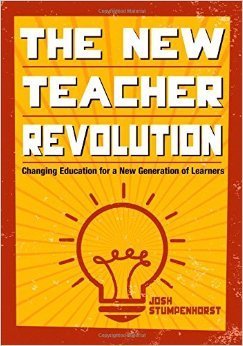
Award-winning teacher Josh Stumpenhorst has created a much-needed resource to guide teachers through this process with the publication of The New Teacher Revolution . Josh articulates how teachers have to be ready and willing to change the way they think about teaching to be able to effectively work with this new generation of learners. Education needs a revolution of ideas, pedagogy, and the very way in which we talk about teaching and learning. The status quo has largely been upheld and the system is rarely challenged or pushed back upon. Josh emphasizes that teachers need to take control of their profession and look for ways in which they can encourage and foster change. Josh’s book outlines and discusses five key areas that teacher’s should focus their energy on if they want to see change and start this revolution.
Classroom Management - Simply put, teachers cannot force a child to do anything they do not want to do. They must find ways to use relationships and empowerment rather than fear and punishments as a way to effectively work with kids. Motivation – Teachers need to move past the notion that kids will do anything for a Jolly Rancher or extra credit points. Rather there is a need to embrace the power of choice and autonomy to motivate and empower students. A renewed family dynamic is needed. It is no longer acceptable to interact with parents simply on conference and open house nights. Teachers must reach out and engage parents and utilize them as key players in their child’s education. Technology as a Lynchpin – In the age of education technology, teachers have to be savvy in their use but also wary in their adoption. Moving past the notion of shiny and new, it is crucial teachers utilize technology to engage and amplify learning for their students beyond the superficial. Distractions – Many a teacher has played buzzword bingo during a conference or staff meeting. How can we recognize which bandwagons to jump on or which fads will last? There are also inherent issues with education traditions. As in any industry, traditions and legacies exist largely to continue and perpetuate the status quo. In education we have grades, homework, testing, competition and many other practices that we do because “that is what we have always done.” Rather than sticking to what is easiest for the adults, we need to push back, question, and change to meet the needs of our current students. Evolving Practice – For most teachers there is an outlined path to becoming a “better” teacher. It often involves advanced degrees, certifications and evaluations. Yet, most of these fall short of actually improving teaching practice. Teachers need to be seeking alternative ways in which to continue to evolve as educators to stay relevant for the sake of their students.
To embark on a journey of revolution can be a daunting task. Keep in mind there are always those ahead of you on this journey that can advise and guide you. However, it is critical to keep in mind those behind you on this journey as well. It is your obligation to reach out and help bring them along and mentor them as well. The book by Josh Stumpenhorst will not only inspire teachers to become a part of this revolution, but also provide them with the practical strategies to take action and drive change.

Award-winning teacher Josh Stumpenhorst has created a much-needed resource to guide teachers through this process with the publication of The New Teacher Revolution . Josh articulates how teachers have to be ready and willing to change the way they think about teaching to be able to effectively work with this new generation of learners. Education needs a revolution of ideas, pedagogy, and the very way in which we talk about teaching and learning. The status quo has largely been upheld and the system is rarely challenged or pushed back upon. Josh emphasizes that teachers need to take control of their profession and look for ways in which they can encourage and foster change. Josh’s book outlines and discusses five key areas that teacher’s should focus their energy on if they want to see change and start this revolution.
Classroom Management - Simply put, teachers cannot force a child to do anything they do not want to do. They must find ways to use relationships and empowerment rather than fear and punishments as a way to effectively work with kids. Motivation – Teachers need to move past the notion that kids will do anything for a Jolly Rancher or extra credit points. Rather there is a need to embrace the power of choice and autonomy to motivate and empower students. A renewed family dynamic is needed. It is no longer acceptable to interact with parents simply on conference and open house nights. Teachers must reach out and engage parents and utilize them as key players in their child’s education. Technology as a Lynchpin – In the age of education technology, teachers have to be savvy in their use but also wary in their adoption. Moving past the notion of shiny and new, it is crucial teachers utilize technology to engage and amplify learning for their students beyond the superficial. Distractions – Many a teacher has played buzzword bingo during a conference or staff meeting. How can we recognize which bandwagons to jump on or which fads will last? There are also inherent issues with education traditions. As in any industry, traditions and legacies exist largely to continue and perpetuate the status quo. In education we have grades, homework, testing, competition and many other practices that we do because “that is what we have always done.” Rather than sticking to what is easiest for the adults, we need to push back, question, and change to meet the needs of our current students. Evolving Practice – For most teachers there is an outlined path to becoming a “better” teacher. It often involves advanced degrees, certifications and evaluations. Yet, most of these fall short of actually improving teaching practice. Teachers need to be seeking alternative ways in which to continue to evolve as educators to stay relevant for the sake of their students.
To embark on a journey of revolution can be a daunting task. Keep in mind there are always those ahead of you on this journey that can advise and guide you. However, it is critical to keep in mind those behind you on this journey as well. It is your obligation to reach out and help bring them along and mentor them as well. The book by Josh Stumpenhorst will not only inspire teachers to become a part of this revolution, but also provide them with the practical strategies to take action and drive change.
Published on April 02, 2015 10:01



